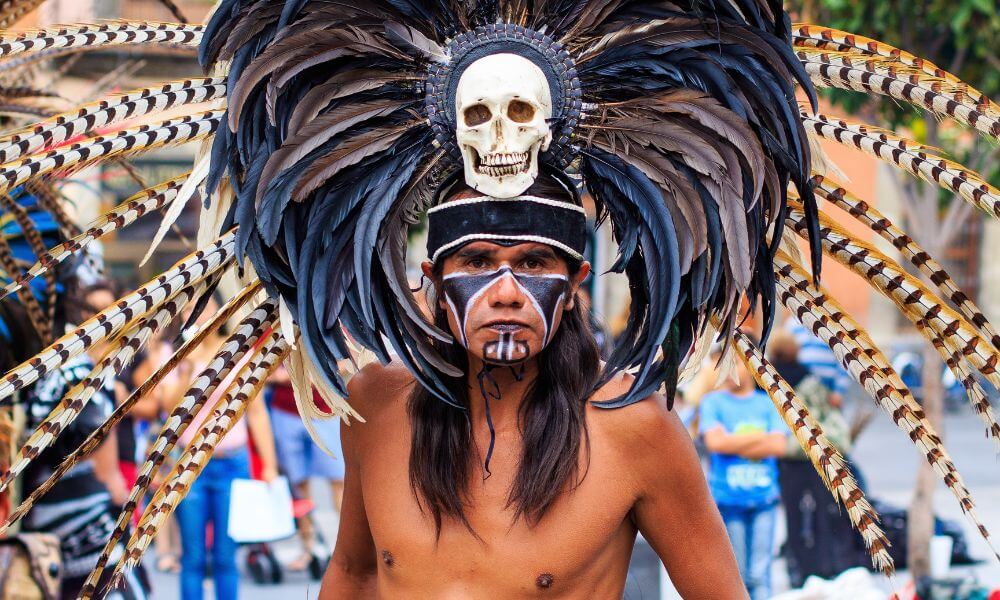The Aztecs were a nomadic tribe in Northern Mexico that flourished from the 1300s to 1521. They spoke a language known as Nahuatl which is still spoke today and as of 2020, there are 1.7 million native speakers in Mexico.
Nahuatl, also known as Aztec or Mexicano, belongs to the Uto-Aztecan language family.
There are many varieties of Nahuatl and as such is considered by some to not be just one language, but a group of languages.
Up until the 16th century, Nahuatl used Aztec script, at which point it was replaced by the Latin alphabet.

What are Uto-Aztecan Languages?
Uto-Aztecan is a family of indigenous languages of the Americas, consisting of over thirty languages.
These languages are found almost exclusively in Western United States and Mexico.
The Uto-Aztecan language family is one of the largest linguistic families in the Americas when it comes to number of native speakers, number of languages and geographic extension.
As of the latest count, there are 61 languages in the family with over 1.9 million speakers. Nahuatl speakers account for over 85% of these.
What Languages are Indigenous to Mexico?
The Uto-Aztecan languages are commonly broken up into seven branches: Numic, Takic, Hopi, Tübatulabal, Piman, Taracahitic and Corachol-Aztecan. Numic, Takic, Hopi and Tübatulabal are considered by some to make up Northern Uto-Aztecan while Piman, Taracahitic and Corachol-Aztecan are considered to make up Southern Uto-Aztecan.
As society changes and new languages come in to replace the ones spoken by these indigenous people, many Uto-Aztecan languages are at a serious risk of going extinct.
It has been theorised that by 2100 somewhere between 50% and 90% of the world’s languages will have either died out or be critically endangered.
Did Aztecs and Mayans Speak the Same Language?
No, Aztecs and Mayans did not speak the same language.
The Maya region covered a large area, comprising of south-eastern Mexico, the entirety of Guatemala and Belize and the western points of Honduras and El Salvador.
The Mayans spoke a language known as Proto-Mayan as far back as 2000 BC, which predates the Aztecs by over three millennia.
Proto-Mayan then broke off into various branches and as of 2001 there were 32 separate descendants of the language in existence.
The most spoken language of Mayan descent today is Yucatec Maya (Maaya t’aan) with close to 775,000 speakers.
Tzeltal Maya (K’op o winik atel) has almost 590,000 speakers and Tzotzil Maya (Batsil k’op) has around 550,000.
What Languages are Spoken in Mexico Today?
Mexico is a country with a population of roughly 129 million people which puts it as the tenth most populated country in the world.
The Mexican government recognises 68 national languages, 63 of which are indigenous including around 350 dialects of those languages.
As of 2018, Ethnologue counts a total of 282 indigenous languages spoken in Mexico plus a number of immigrant languages.
Spanish is the most spoken language in Mexico with close to 94% speaking it as their native tongue.
Nahuatl is the second most spoken language with 1.7 million speakers accounting for just below 1.5% of the population.
The third most spoken language in the country is Yucatec Maya with 775,000 speakers.
Many of the remaining indigenous languages have fewer than 1,000 speakers and, in some cases, less than one hundred.
The Kiliwa language spoken in Baja, California in the far Northwest of Mexico had been reported to be the language of 76 people in 2020.
However, in 2018 it was reported that there were only 4 speakers left.
What is the Aztec Script?
Aztec Script, also known as Nahuatl Script, is a pre-Columbian writing system used by the Nahua people.
It derives from writing systems used in Central Mexico such as the Zapotec Script.
There were no letters or alphabets in the Aztec language and the Aztec Script writing system combines ideographic writing with Nahuatl specific phonetic logograms and syllabic signs.
Unlike Mayan Hieroglyphs, Aztec Glyphs did not have a set reading order such as left to right or right to left.
Instead, they could be read in any direction that would form the correct sounds within the context of the glyph.
Aztec logosyllabic writing appears on various artefacts in both painted and carved forms.
One of the best-known artefacts is the Tizoc Stone, also known as the Sacrificial Stone. It was created in the 1480s and wasn’t discovered until 1791.
What Nahuatl Words does English Use?
Whether English speakers realize it or not, they use Nahuatl words every day.
Some of the most common English words have a Nahuatl origin such as chocolate, which originally was Xocolātl or Chocolātl.
Guacamole was originally Ahuacamolli while Avocado was Ahuacatl.
The often-misrepresented fruit, the tomato, also has its roots in Nahuatl, having been known as Tomatl.
The words from Nahuatl go beyond food though.
As is to be expected, the word for Aztec came from Nahuatl and was originally Aztecatl.
Coyote also finds its roots here as Coyotl.
The Aztecs were originally a race of nomadic people in Northern Mexico.
They spoke an Uto-Aztecan language known as Nahuatl which was written in an Aztec Script.
It is still spoken today by over 1.7 million people in Mexico (<1.5% of the population), making it the second largest language in the country behind Spanish.
More in Languages
- What Language Did Abraham Speak? (Explained!)
- What Language Did Adam And Eve Speak? (Answered!)
- What Language Did Albert Einstein Speak? (Wunderbar!)
- What Language Did Alexander The Great Speak? (Answered!)
- What Language Did Anne Frank Speak? (It May Surprise You!)
- What Language Did Beethoven Speak? (Revealed!)
- What Language Did Boudicca Speak? (Explained!)
- What Language Did Bruce Lee Speak? (Answered!)
- What Language Did Catherine The Great Speak? (Answered!)
- What Language Did Cavemen Speak? (Explained!)
- What Language Did Christopher Columbus Speak? (Answered!)
- What Language Did Cleopatra Speak? (Explained!)
- What Language Did George Washington Speak? (Revealed!)
- What Language Did Jesus Speak? (Answered!)
- What Language Did Julius Caesar Speak? (Find Out!)
- What Language Did Moses Speak? (Answered!)
- What Language Did Mozart Speak? (Answered!)
- What Language Did Noah Speak? (Explained!)
- What Language Did The Anglo Saxons Speak? (Answered!)
- What Language Did The Aztecs Speak? (Answered!)
- What Language Did The Buddha Speak? (Explained!)
- What Language Did The Vikings Speak? (Answered!)
- What Languages Are Spoken In Afghanistan? (Find Out!)
- What Languages Are Spoken In Africa? (Revealed!)
- What Languages Are Spoken In Albania? (Answered!)
- What Languages Are Spoken In America? (Answered!)
- What Languages Are Spoken In Antwerp? (Find Out)
- What Languages Are Spoken In Argentina? (Revealed!)
- What Languages Are Spoken In Australia? (Find Out!)
- What Languages Are Spoken In Austria? (Answered!)
- What Languages Are Spoken In Bangladesh? (Revealed!)
- What Languages Are Spoken In Barcelona? (Answered!)
- What Languages Are Spoken In Belgium? (Revealed!)
- What Languages Are Spoken In Bolivia? (Answered!)
- What Languages Are Spoken In Bosnia? (Answered!)
- What Languages Are Spoken In Brazil? (Find Out!)
- What Languages Are Spoken In Budapest? (Revealed!)
- What Languages Are Spoken In China? (Answered!)
- What Languages Are Spoken In Colombia? (Revealed!)
- What Languages Are Spoken In Croatia? (Answered!)
- What Languages Are Spoken In Cuba? (Revealed!)
- What Languages Are Spoken In Cyprus? (Revealed!)
- What Languages Are Spoken In Denmark? (Find Out!)
- What Languages Are Spoken In Djibouti? (Answered!)
- What Languages Are Spoken In Ecuador? (Find Out!)
- What Languages Are Spoken In Egypt? (Answered!)
- What Languages Are Spoken In El Salvador? (Answered!)
- What Languages Are Spoken In England? (Find Out!)
- What Languages Are Spoken In Estonia? (Revealed!)
- What Languages Are Spoken In Ethiopia? (Answered!)
- What Languages Are Spoken In Fiji? (Revealed!)
- What Languages Are Spoken In Japan? (Answered!)
- What Languages Are Spoken In Morocco? (Answered!)
- What Languages Are Spoken In South Africa? (Answered!)

